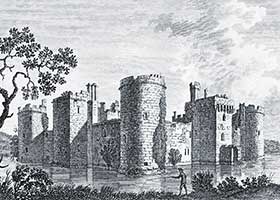There was need of strong walls, as the French often at that period ravaged the coast of Sussex, burning towns and manor-houses. Clark, the great authority on castles, says that "Bodiam is a complete and typical castle of the end of the fourteenth century, laid out entirely on a new site, and constructed after one design and at one period. It but seldom happens that a great fortress is wholly original, of one, and that a known, date, and so completely free from alterations or additions." Bodiam CastleIt is nearly square, with circular tower sixty-five feet high at the four corners, connected by embattled curtain-walls, in the centre of each of which square towers rise to an equal height with the circular. The gateway is a large structure composed of two flanking towers defended by numerous oiletts for arrows, embattled parapets, and deep machicolations. Over the gateway are three shields bearing the arms of Bodiam, Dalyngrudge, and Wardieu. A huge portcullis still frowns down upon us, and two others opposed the way, while above are openings in the vault through which melted lead, heated sand, pitch, and other disagreeable things could be poured on the heads of the foe. In the courtyard on the south stands the great hall with its oriel, buttery, and kitchen, and amidst the ruins you can discern the chapel, sacristy, ladies' bower, presence chamber. The castle stayed not long in the family of the builder, his son John probably perishing in the wars, and passed to Sir Thomas Lewknor, who opposed Richard III, and was therefore attainted of high treason and his castle besieged and taken. It was restored to him again by Henry VII, but the Lewknors never resided there again. Waller destroyed it after the capture of Arundel, and since that time it has been left a prey to the rains and frosts and storms, but manages to preserve much of its beauty, and to tell how noble knights lived in the days of chivalry. |

